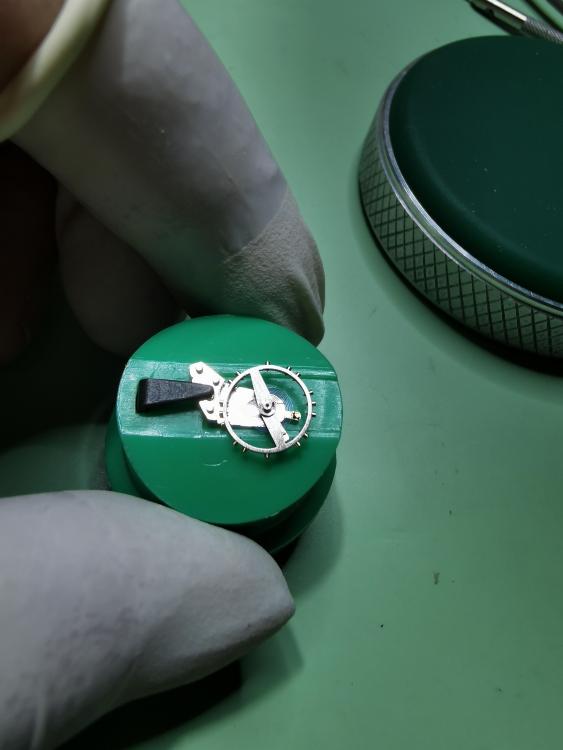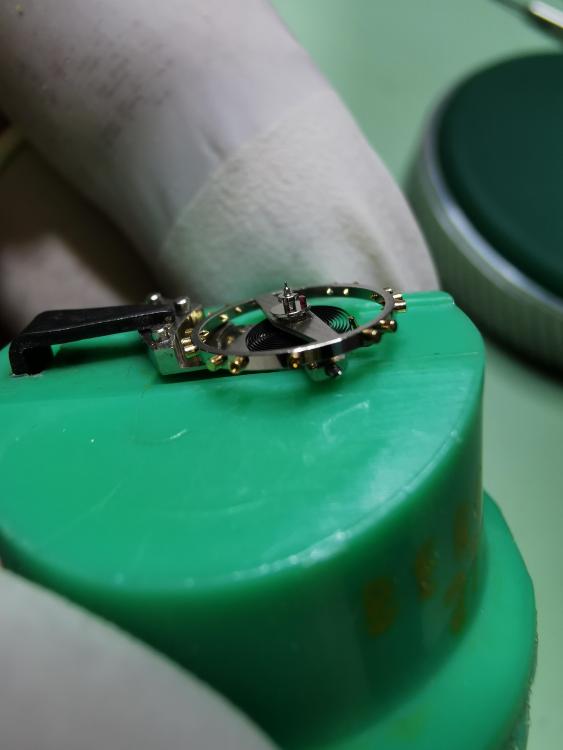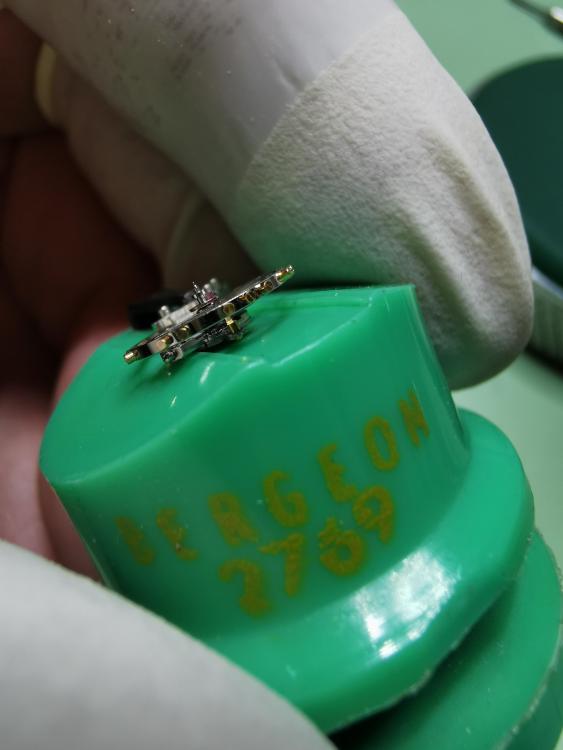Leaderboard
Popular Content
Showing content with the highest reputation on 09/25/21 in all areas
-
I thought I'd give you something to ponder? Somewhere out there online I seen better pictures of one of these disassembled. But finding pictures at all is hard so this was the easiest one to find and it has a description which I thought you'd find interesting? The first stage uses cleaning fluid and ultrasonic basically standard cleaning of the watch. The second uses a fluid which gets distilled so it's nice and clean. Notice what kind of fluid this is? The third is even more interesting in that this is the surface treatment. Normally extremely expensive but here they use powdered steric acid that they vaporize. https://www.worthpoint.com/worthopedia/greiner-ultrason-cleaning-machine-465667345 Then there's another way to look at the isopropyl alcohol problem let's look at a group of people who love to dissolve their shellac they're not happy unless it's dissolved and let's see what they say about isopropyl alcohol. https://www.finewoodworking.com/forum/isopropyl-or-denatured-alcohol2 points
-
Not at all- ethyl alcohol is the alcohol for dissolving shellac. As it is frequently abused, it's sold mostly as denatured alcohol or methylated spirits. The additives make it undrinkable but it functions quite well otherwise*. Other alcohols will dissolve it, but not as effectively. If shellac has softened from contact with alcohol, it will re-harden as the alcohol evaporates, this is the basis for shellac finishes for wood. Denatured/methylated is also the right alcohol for an alcohol lamp- aka spirit lamp in the U.K. The above mention of boiling out in a test tube is because there's a big difference between softening shellac and completely removing it. I used to go to the trouble of completely removing it when setting up an escapement, only re-applying once I was happy with my stone positions. Nowadays I don't bother. But I found that even a long, like 30 minute or more soak at room temperature usually left some remnants, thus the boiling. (the test tube allows you to point the end far from the flame- even so I have ejected a plume of flame along with a fork before!) * There are no real standards as to what is done to "denature" ethyl alcohol. So sometimes it's cut with water to bulk it up, and sometimes mixed with some cheaper (and poisonous) methyl alcohol- thus the U.K. name, and usually has a couple to several other chemicals added to make it very unappealing or even deadly to drink, and difficult to separate the ethyl back out through normal distillation methods. I have noticed that some brands burn very poorly in my alcohol lamps, in spite of being sold as lamp fuel. Some burn very well. Probably more water in the poor one.2 points
-
Hello fellow members, hope you all are well. And I hope your families are well during these times.1 point
-
I was going through my cabinets about a month ago and found this tool and have been using it to dismantle the balance. It is fantastic for wrist watches. Normally I would dismantle in the plate if I can but that's not always easy, so I would just hold it in my fingers with the balance wheel touching the bench. This tool is spring loaded with a powerful spring and you can hold the tool in one hand and unscrew with the other. I have had a look around for this tool and it looks like they are hard to find.1 point
-
If it hasn't run in some years I recommend a "soft start", ramping up voltage with a Variac. I'm sure you're familiar with reforming caps . These things (all the old Greiner stuff- new too) is built to an extraordinarily high standard, but best to be safe. They also have selenium rectifiers which are a debate starter on electrinics forums, but the 3 I own all the Siemens rectifier blocks are nice and flat, no hint of toxic smoke coming out. Maybe Greiner bought higher spec? I've had some Revox amps that were super bulged out, same era.1 point
-
Like clockmakers do. Fit and set alarm hand first to a precise hour, advance time slowly, when it will sound fit time hands accordingly. No, seconds hand don't count1 point
-
Hi I have on file a Citizen 3100 series manual of 15 pages including exploded drawings. Unfortunatly the site has stopped accepting PDF format so if you want a copy PM me cheers1 point
-
As the man said there are many and varied opinions, as a starter as we are at the begining you can use Lighter fuel, and rinse in IPA then blow dry carefully. as your skills develop you may wish to go further and get a cheap ultra sonic. They can be had for about £20 used for jewelery, bracelets etc and they are adequate, I have one myself and it does a crediable job. So initially you dont need a great capital outlay at this point. Just take your time and enjoy what you are doing.1 point
-
The machine John linked is what I used for a good 15 years.* I sought one out on Derek Pratt's advice, as he'd bought one and found it outperformed anything else on the market at the time. It is a truly cool machine, and the "virgin" final rinse every time is the key. Also, parts are strung on little "trees" so more exposed to the cleaning action. The first bath is also pumped through a filter with a magnet inside to catch dust and metal crap. As it's around 60 years old I've recently moved on to the current Greiner ACS 900, and with their solutions I'm very happy. *the old Ultrason II is still running and is particularly good when cleaning parts that will be plated or blued.1 point
-
That is terrible. Degrease with petroleum ether, of if you want spend more per same quantity and get inferior purity, lighter fluid. Then rinse in demineralized water, not distilled which is for laboratory use. No problem with IPA on balance and pallets fork as long it's a quick bath, 10 secs or so. That will disperse parts and make you desperate. Just let them on in baskets or on the paper. Also, there are many many questions identical to your, please do a search and have a read around.1 point
-
1 point
-
Hello Andrew and welcome to the forum. https://www.timezonewatchschool.com/ have a look at this site there is a mine if information and also a glossary on watch parts , and drawings, Cousins uk watch parts have a documents section with a lot of tech information on.1 point
-
The Greiner instructions were to rinse the fork and balance complete for about 30 seconds in clean rinse (alcohol), and that has never given me a problem. I did sometimes rinse them with the other parts, and then I would frequently need to reshellac- but as I retouch the escapement on probably 1 out of 3 (maybe even 50%) watches it isn't a big deal to reshellac. The pallet stones should be a friction fit so even if the shellac goes away the remain in place. Methylated spirits is what they call denatured alcohol in the U.K. It's ethyl alcohol with stuff added so you can't drink it.1 point
-
That's never necessary. There are formulas to calculate length when it's in the barrel e.g. https://theindex.nawcc.org/CalcMainspringLength.php And when it's outside just use a cotton thread along it. Anyway, a difference like 5% in normally negligible.1 point
-
Oh no, I always though it was India Pale Ale. I guess this explains the sticky hairsprings. Oh well, you learn something new every day!1 point
-
Shellac is absolutely soluble in IPA. Shellac varnish or french polish is basically shellac dissolved in either IPA or methylated spirit. Quite a lot of wood finishers prefer to use IPA as the varnish has a slightly longer drying time than if it is made with meths. It is however a question of prolonged exposure here. It can take 24 hours or so to dissolve a pound of shellac flakes in a gallon of IPA. Although the amount of shellac involved in watch movements is infinitesimally small by comparison, we are also only talking about a few minutes exposure at most.1 point
-
1 point
-
1 point
-
I wouldn't repair them. Always sent them back to Dundee Scotland.1 point











